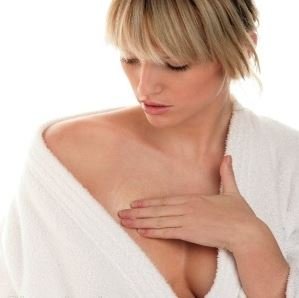Estrogen, which is produced by the ovaries in the first half of the menstrual cycle, stimulates the growth of milk ducts in the breasts. The increasing level of estrogen leads to ovulation halfway through the cycle. Next, the hormone progesterone takes over in the second half of the cycle, stimulating the formation of the milk glands. These hormones are believed to be responsible for the cyclical changes, like the swelling, pain, and tenderness that many women experience in their breasts just before menstruation.

During menstruation, many women also experience changes in breast texture. Breasts feel particularly lumpy. These are the glands in the breast enlarging to prepare for a possible pregnancy. If pregnancy does not happen, the breasts return to normal size. Once menstruation begins, the cycle begins again.
Normal Breast Development and Changes | Johns Hopkins …

One large US study found that 69 percent of women attending an ob-gyn clinic experienced regular premenstrual breast pain.
Breast Tenderness Before Period | HealthyWomen
Most women find that their breasts get larger and swollen during their menstrual cycle.

Breasts that are getting larger is a normal part of the growth process that happens during adolescence and into womanhood. However, throughout their adult life, many women’s breasts continue to grow and get larger. The reasons why some women experience changes in the size of their breasts can vary. Pregnancy almost always causes breasts to get bigger. But sometimes, breasts can grow larger without being pregnant. For example, weight gain and hormonal fluctuations can also cause breasts to get larger. Whatever the reason, it is only natural to be concerned if you experience a sudden increase in breast size.
Surprising Reasons Why Women’s Breasts are Getting Larger

Lifestyle remedies:
Lifestyle changes can also help manage premenstrual breast swelling and tenderness. Wear a supportive sports bra when symptoms are at their worst. You may choose to wear the bra at night as well, to provide extra support while you sleep.
Diet can play a role in breast pain. Caffeine, alcohol, and foods that are high in fat and salt can increase discomfort. Reducing or eliminating these substances from your diet in the week or two before your period may help manage or prevent symptoms.
Certain vitamins and minerals may also help relieve breast pain and related PMS symptoms. The U.S. Department of Health and Human Services Office on Women’s Health recommends consuming 400 international units (IU) of vitamin E and 400 milligrams of magnesium daily to help ease PMS symptoms.
Choose a variety of foods rich in these nutrients, such as:
peanuts
spinach
hazelnuts
corn, olive, safflower, and canola oils
carrots
bananas
oat bran
avocados
brown rice
Your doctor may also recommend vitamin supplements.
Premenstrual Breast Swelling and Tenderness – Healthline

No Comments Yet